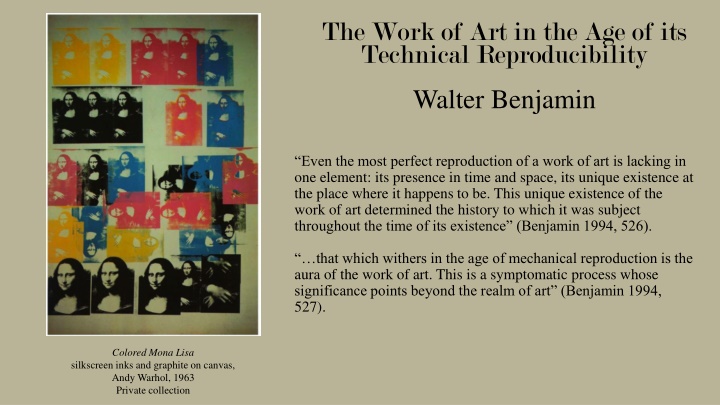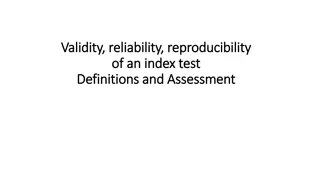The Work of Art in the Age of Its Technical Reproducibility by Walter Benjamin
Walter Benjamin discusses the impact of technological reproduction on art, specifically the loss of aura through mechanical processes. He emphasizes the significance of art's unique existence in time and space, examining how modern art has evolved in response to new modes of reproduction. Benjamin's work delves into the implications of mechanical reproduction on the authenticity and ritual status of artworks, acknowledging both its positive aspects and potential for perversion by fascism.
Download Presentation

Please find below an Image/Link to download the presentation.
The content on the website is provided AS IS for your information and personal use only. It may not be sold, licensed, or shared on other websites without obtaining consent from the author.If you encounter any issues during the download, it is possible that the publisher has removed the file from their server.
You are allowed to download the files provided on this website for personal or commercial use, subject to the condition that they are used lawfully. All files are the property of their respective owners.
The content on the website is provided AS IS for your information and personal use only. It may not be sold, licensed, or shared on other websites without obtaining consent from the author.
E N D
Presentation Transcript
The Work of Art in the Age of its Technical Reproducibility Walter Benjamin Even the most perfect reproduction of a work of art is lacking in one element: its presence in time and space, its unique existence at the place where it happens to be. This unique existence of the work of art determined the history to which it was subject throughout the time of its existence (Benjamin 1994, 526). that which withers in the age of mechanical reproduction is the aura of the work of art. This is a symptomatic process whose significance points beyond the realm of art (Benjamin 1994, 527). Colored Mona Lisa silkscreen inks and graphite on canvas, Andy Warhol, 1963 Private collection
Walter Benjamin Walter Benjamin was a German Jewish philosopher, cultural critic and essayist. An eclectic thinker, combining elements of German idealism, Romanticism, Western Marxism, and Jewish mysticism, Benjamin made enduring and influential contributions to aesthetic theory, literary criticism, and historical materialism. He was associated with the Frankfurt School, and also maintained formative friendships with thinkers such as playwright Bertolt Brecht and Kabbalah scholar Gershom Scholem. He was also related to German political theorist and philosopher Hannah Arendt through her first marriage to Benjamin's cousin, G nther Anders. Among Benjamin's best known works are the essays "The Task of the Translator" (1923), "The Work of Art in the Age of Mechanical Reproduction" (1935), and "Theses on the Philosophy of History" (1940).. In 1940, at the age of 48, Benjamin committed suicide at Portbou on the French Spanish border while attempting to escape from the invading Wehrmacht. Though popular acclaim eluded him during his life, the decades following his death won his work posthumous renown. Walter Benjamin (1892-1940)
The Work of Art in the Age of its Technical Reproducibility The basic argument of this essay is that modern art develops as a response to new modes of technological reproduction (lithography, photography and film). Benjamin argues that these mechanical processes deprive the artwork of its aura . The aura is (was) the ritual status of the artwork as a genuine , unique object produced by the hand of the artist. Mechanical reproduction destroys the aura because it enables multiple copies to be created by mechanical means; this strips the artwork of its uniqueness. Benjamin is essentially positive about the passing of the aura, but he also fears about fascism's ability to pervert the new media. Walter Benjamin (1892-1940)
The Work of Art in the Age of its Technical Reproducibility In section I of the text, not included in the selection in our reader, Benjamin explains that works of art have always been reproducible, but something new has occurred in the modern age with the development of mechanical means of reproduction. He closes the first section with this observation: Around 1900 technical reproduction had reached a standard that not only permitted it to reproduce all transmitted works of art and thus to cause the most profound change in their impact upon the public; it also had captured a place of its own among the artistic processes. For the study of this standard nothing is more revealing than the nature of the repercussions that these two different manifestations the reproduction of works of art and the art of the film have had on art in its traditional form.
The Work of Art in the Age of its Technical Reproducibility In section II of the text, where our selection in the reader begins, Benjamin draws out the consequences of this reproducibility. He claims that something is lost when the work of art can be so easily reproduced: The situations into which the product of mechanical reproduction can be brought may not touch the actual work of art, yet the quality of its presence is always depreciated. This holds not only for the art work but also, for instance, for a landscape which passes in review before the spectator in a movie. In the case of the art object, a most sensitive nucleus namely, its authenticity is interfered with whereas no natural object is vulnerable on that score. The authenticity of a thing is the essence of all that is transmissible from its beginning, ranging from its substantive duration to its testimony to the history which it has experienced. Since the historical testimony rests on the authenticity, the former, too, is jeopardized by reproduction when substantive duration ceases to matter. And what is really jeopardized when the historical testimony is affected is the authority of the object. (Benjamin 1994, 527)
The Work of Art in the Age of its Technical Reproducibility This is where he emphasizes that the aura of the work of art is diminished by this reproducibility: One might subsume the eliminated element in the term aura and go on to say: that which withers in the age of mechanical reproduction is the aura of the work of art. This is a symptomatic process whose significance points beyond the realm of art. One might generalize by saying: the technique of reproduction detaches the reproduced object from the domain of tradition. By making many reproductions it substitutes a plurality of copies for a unique existence. And in permitting the reproduction to meet the beholder or listener in his own particular situation, it reactivates the object reproduced. These two processes lead to a tremendous shattering of tradition which is the obverse of the contemporary crisis and renewal of mankind. Both processes are intimately connected with the contemporary mass movements. Their most powerful agent is the film. (Benjamin 1994, 527)
The Work of Art in the Age of its Technical Reproducibility In section III of the text Benjamin points out how even human perception itself changes with the mode of existence. In this we see the influence of Hegel on how reality is historical, and also Marx, who drew from Hegel the importance of paying attention to the ways in which our understanding, even perception itself, is shaped by concrete social and historical conditions: During long periods of history, the mode of human sense perception changes with humanity s entire mode of existence. The manner in which human sense perception is organized, the medium in which it is accomplished, is determined not only by nature but by historical circumstances as well. The fifth century, with its great shifts of population, saw the birth of the late Roman art industry and the Vienna Genesis, and there developed not only an art different from that of antiquity but also a new kind of perception. (Benjamin 1994, 528)
The Work of Art in the Age of its Technical Reproducibility In section IV of the text Benjamin draws out the consequences of this reproducibility and loss of the aura of the work of art. Whereas the earliest art has a ritual function (he talks of prehistoric cave paintings), and art was always embedded in the fabric of tradition, in the age of technical reproducibility art loses its ritual function and its embeddedness in tradition. According to Benjamin this produces a crisis for art: With the advent of the first truly revolutionary means of reproduction, photography, simultaneously with the rise of socialism, art sensed the approaching crisis which has become evident a century later. At the time, art reacted with the doctrine of l art pour l art, that is, with a theology of art. This gave rise to what might be called a negative theology in the form of the idea of pure art, which not only denied any social function of art but also any categorizing by subject matter. (Benjamin 1994, 529)
The Work of Art in the Age of its Technical Reproducibility Benjamin then emphasizes an all-important insight : An analysis of art in the age of mechanical reproduction must do justice to these relationships, for they lead us to an all-important insight: for the first time in world history, mechanical reproduction emancipates the work of art from its parasitical dependence on ritual. To an ever greater degree the work of art reproduced becomes the work of art designed for reproducibility. From a photographic negative, for example, one can make any number of prints; to ask for the authentic print makes no sense. But the instant the criterion of authenticity ceases to be applicable to artistic production, the total function of art is reversed. Instead of being based on ritual, it begins to be based on another practice politics. (Benjamin 1994, 529)
The Work of Art in the Age of its Technical Reproducibility In section V of the text Benjamin makes a distinction between two ways in which works of art are received and valued: the cult value (of earlier ritual art) and the exhibition value. In the age of technical reproducibility Benjamin argues that there is a dramatic change in which the exhibition value becomes predominant: With the different methods of technical reproduction of a work of art, its fitness for exhibition increased to such an extent that the quantitative shift between its two poles turned into a qualitative transformation of its nature. This is comparable to the situation of the work of art in prehistoric times when, by the absolute emphasis on its cult value, it was, first and foremost, an instrument of magic. Only later did it come to be recognized as a work of art. In the same way today, by the absolute emphasis on its exhibition value the work of art becomes a creation with entirely new functions, among which the one we are conscious of, the artistic function, later may be recognized as incidental. This much is certain: today photography and the film are the most serviceable exemplifications of this new function. (Benjamin 1994, 529)
The Work of Art in the Age of its Technical Reproducibility In section VI of the text Benjamin focuses on the problem of photography. He thinks that the exhibition value becomes even more dominant through photography. In photography, exhibition value begins to displace cult value all along the line. But cult value does not give way without resistance. It retires into an ultimate retrenchment: the human countenance. It is no accident that the portrait was the focal point of early photography. The cult of remembrance of loved ones, absent or dead, offers a last refuge for the cult value of the picture. For the last time the aura emanates from the early photographs in the fleeting expression of a human face. This is what constitutes their melancholy, incomparable beauty. But as man withdraws from the photographic image, the exhibition value for the first time shows its superiority to the ritual value. (Benjamin 1994, 530)
The Work of Art in the Age of its Technical Reproducibility Benjamin goes on to emphasize a hidden political significance in the development of photography: To have pinpointed this new stage constitutes the incomparable significance of Atget, who, around 1900, took photographs of deserted Paris streets. It has quite justly been said of him that he photographed them like scenes of crime. The scene of a crime, too, is deserted; it is photographed for the purpose of establishing evidence. With Atget, photographs become standard evidence for historical occurrences, and acquire a hidden political significance. They demand a specific kind of approach; free-floating contemplation is not appropriate to them. They stir the viewer; he feels challenged by them in a new way. At the same time picture magazines begin to put up signposts for him, right ones or wrong ones, no matter. (Benjamin 1994, 530)
The Work of Art in the Age of its Technical Reproducibility Our selection omits sections VII and VIII of the text In section IX Benjamin turns to the subject of film. He calls to attention some differences between the theater, where live actors perform on the stage before an audience, and films where the actors perform before a camera: For the film, what matters primarily is that the actor represents himself to the public before the camera, rather than representing someone else. [ ] This situation might also be characterized as follows: for the first time and this is the effect of the film man has to operate with his whole living person, yet forgoing its aura. For aura is tied to his presence; there can be no replica of it. The aura which, on the stage, emanates from Macbeth, cannot be separated for the spectators from that of the actor. However, the singularity of the shot in the studio is that the camera is substituted for the public. Consequently, the aura that envelops the actor vanishes, and with it the aura of the figure he portrays. (Benjamin 1994, 531)
The Work of Art in the Age of its Technical Reproducibility In section X Benjamin draws out more of the consequences of shriveling of the aura of the work of art in film: The film responds to the shriveling of the aura with an artificial build-up of the personality outside the studio. The cult of the movie star, fostered by the money of the film industry, preserves not the unique aura of the person but the spell of the personality, the phony spell of a commodity. So long as the movie-makers capital sets the fashion, as a rule no other revolutionary merit can be accredited to today s film than the promotion of a revolutionary criticism of traditional concepts of art. We do not deny that in some cases today s films can also promote revolutionary criticism of social conditions, even of the distribution of property. (Benjamin 1994, 532)
The Work of Art in the Age of its Technical Reproducibility In section XI Benjamin continues to draw the contrast between live theater and a film: The shooting of a film, especially of a sound film, affords a spectacle unimaginable anywhere at any time before this. It presents a process in which it is impossible to assign to a spectator a viewpoint which would exclude from the actual scene such extraneous accessories as camera equipment, lighting machinery, staff assistants, etc. unless his eye were on a line parallel with the lens. This circumstance, more than any other, renders superficial and insignificant any possible similarity between a scene in the studio and one on the stage. In the theater one is well aware of the place from which the play cannot immediately be detected as illusionary. There is no such place for the movie scene that is being shot. (Benjamin 1994, 533)
The Work of Art in the Age of its Technical Reproducibility Benjamin concludes this section further developing this analogy: Magician and surgeon compare to painter and cameraman. The painter maintains in his work a natural distance from reality, the cameraman penetrates deeply into its web. There is a tremendous difference between the pictures they obtain. That of the painter is a total one, that of the cameraman consists of multiple fragments which are assembled under a new law. Thus, for contemporary man the representation of reality by the film is incomparably more significant than that of the painter, since it offers, precisely because of the thoroughgoing permeation of reality with mechanical equipment, an aspect of reality which is free of all equipment. And that is what one is entitled to ask from a work of art. (Benjamin 1994, 534)
The Work of Art in the Age of its Technical Reproducibility In section XII Benjamin continues to draw out some of the differences between paintings and films: Mechanical reproduction of art changes the reaction of the masses toward art. The reactionary attitude toward a Picasso painting changes into the progressive reaction toward a Chaplin movie. [ ] Again, the comparison with painting is fruitful. A painting has always had an excellent chance to be viewed by one person or by a few. The simultaneous contemplation of paintings by a large public, such as developed in the nineteenth century, is an early symptom of the crisis of painting, a crisis which was by no means occasioned exclusively by photography but rather in a relatively independent manner by the appeal of art works to the masses. (Benjamin 1994, 534-35)
Bibliography Benjamin, Walter. 1994. The Work of Art in the Age of its Technical Reproducibility in Art and Its Significance, 3rd ed. Edited by Stephen David Ross. Albany: State University of New York Press. [1936]























